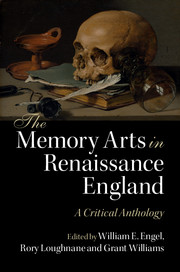Book contents
- Frontmatter
- Dedication
- Contents
- List of figures
- Acknowledgements
- A note on abbreviations
- Introduction
- PART I The art of memory
- PART II Rhetoric and poetics
- PART III Education and science
- PART IV History and philosophy
- PART V Religion and devotion
- Introduction to Part V
- V.1 Thomas More, A Treatise (Unfinished) upon these Words of Holy Scripture (1522)
- V.2 John Foxe, Acts and Monuments (1563)
- V.3 Thomas Playfere, The Pathway to Perfection (1593)
- V.4 Joseph Hall, selected works
- V.5 Richard Day, A Book of Christian Prayers (1608)
- V.6 Daniel Featley, ‘Four Rows of Precious Stones’ (1610)
- V.7 Lewis Bayly, The Practice of Piety (1613)
- V.8 John Donne, ‘Sermon, preached at Lincoln's Inn’ (1649)
- V.9 Stephen Jerome, A Minister's Mite (1650)
- V.10 E.M., Ashrea (1665)
- PART VI Literature
- Index
- References
V.10 - E.M., Ashrea (1665)
from PART V - Religion and devotion
Published online by Cambridge University Press: 05 August 2016
- Frontmatter
- Dedication
- Contents
- List of figures
- Acknowledgements
- A note on abbreviations
- Introduction
- PART I The art of memory
- PART II Rhetoric and poetics
- PART III Education and science
- PART IV History and philosophy
- PART V Religion and devotion
- Introduction to Part V
- V.1 Thomas More, A Treatise (Unfinished) upon these Words of Holy Scripture (1522)
- V.2 John Foxe, Acts and Monuments (1563)
- V.3 Thomas Playfere, The Pathway to Perfection (1593)
- V.4 Joseph Hall, selected works
- V.5 Richard Day, A Book of Christian Prayers (1608)
- V.6 Daniel Featley, ‘Four Rows of Precious Stones’ (1610)
- V.7 Lewis Bayly, The Practice of Piety (1613)
- V.8 John Donne, ‘Sermon, preached at Lincoln's Inn’ (1649)
- V.9 Stephen Jerome, A Minister's Mite (1650)
- V.10 E.M., Ashrea (1665)
- PART VI Literature
- Index
- References
Summary
About the author
E.M., appearing at the end of the dedicatory epistle (A3v), refers probably to Edward Manning, a pamphleteer, or Edward Mico (d. 1678), an English Jesuit.
About the text
Although relatively short on images, this work shares many features with typical emblem books, especially Henry Hawkins's Partheneia sacra (1633) and The Devout Heart (1634), which establish distinct points of sustained meditation following Ignatius Loyola's ‘spiritual exercises’.
The arts of memory
The dominant metaphor guiding this devotional manual is a grove of trees, represented visually and followed by a poem and interpretive exposition linking each tree to one of the Beatitudes from the Sermon on the Mount (Matt. 5:1–12; Luke 6:20–6), which in turn are read with respect to eight mnemonic sites placed on the crucified body of Christ. The preface gives ‘a particular account of the design and title of this little work, as also of the advantage of artificial memory therein’ (A4r). The explicitly expressed principles of the art of memory distinguish this work from other emblem books of the period.
Textual notes
Ashrea: or, the grove of beatitudes, represented in emblems: and, by the art of memory (London, 1665), A4r–B1v.
Ashrea
I do here present thee with a little grove of beatitudes, or happinesses, which may be entitled Ashrea, a word, in the Hebrew tongue, signifying a wood or grove; derived from Ashar, which signifies to beatify or make blessed. May it be God's good pleasure, that this our grove may produce the like effect in all those who shall devoutly walk into it. […]
I foresee an objection which some of my readers may make; and therefore I will endeavour to satisfy it. It may be questioned to what end artificial memory should be inserted here, to render a man mindful of beatitude since Aristotle affirms it to be a good, which all men desire; nay, so great a one, according to St Augustine, that both good and evil men are desirous of it? […] To open therefore the eyes and ears of mortals, that they might hear and behold true beatitude, the Son of God incarnate is said to have opened his own mouth, when he preached to his Apostles the Eight Beatitudes.
- Type
- Chapter
- Information
- The Memory Arts in Renaissance EnglandA Critical Anthology, pp. 269 - 272Publisher: Cambridge University PressPrint publication year: 2016



